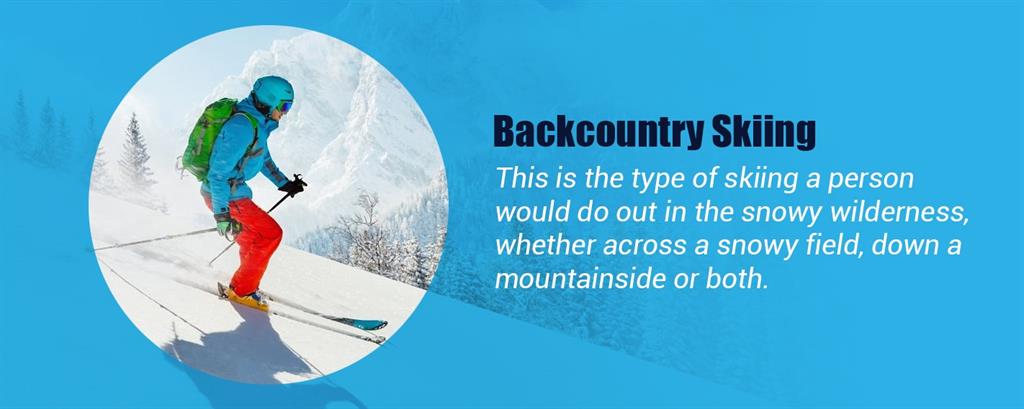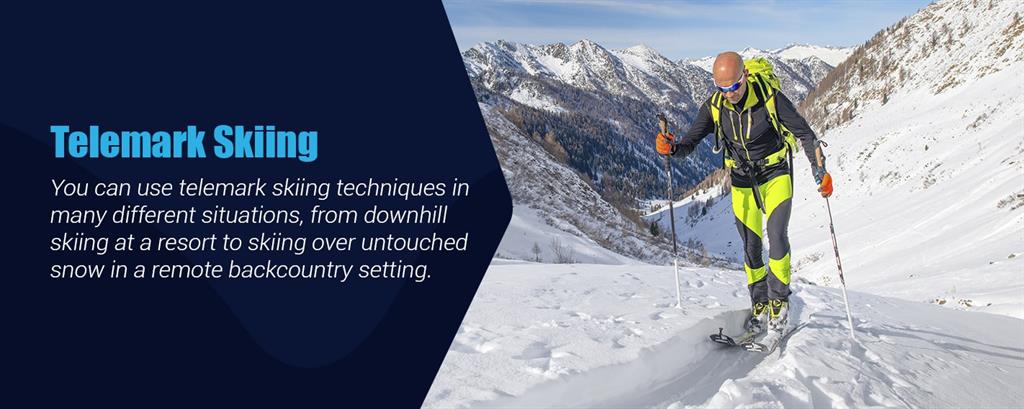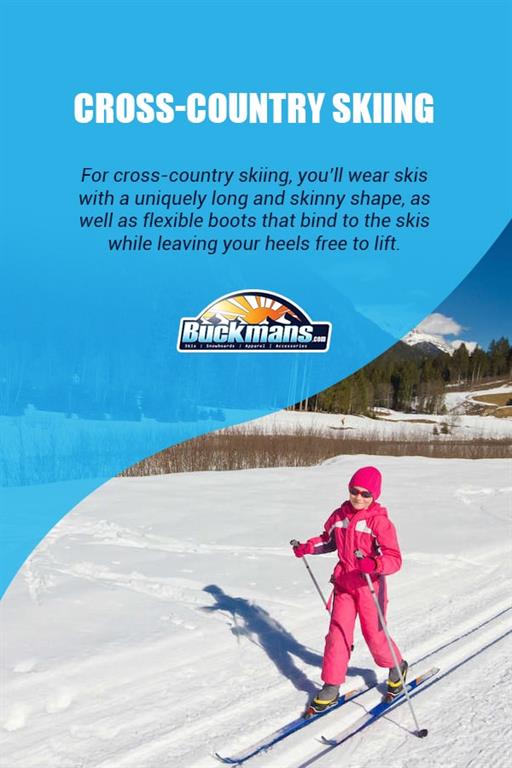 Types-of-Skiing
Types-of-Skiing
Types of Skiing
Posted
by
Matt Gahman
on Tuesday, August 30, 2022
If you’re new to the world of skiing, one of the first things you may notice is the confusing number of terms people throw around. In particular, there may seem to be a ton of different names used for skiing. Perhaps you’ve imagined that all skiing is downhill skiing, but then someone mentions cross-country skiing. Is that different? And then things get even more confusing when you hear someone mention freestyle skiing — is that something else again? The various names and types of skiing go on, and for many of us, the confusion only grows from here.
If you’re feeling overwhelmed and confused, you’re not alone. Like every other niche activity and interest, there’s a lot to learn about skiing, and everyone has to start somewhere. One of the best places to begin your learning is by understanding the difference between the different types of skiing.
That's why we’ve compiled this guide to all the most popular types of skiing techniques and disciplines. Today, we’ll talk about what these techniques are, what sets them apart and what some of the major hallmarks of each one are. By learning this, you’ll have an excellent foundation from which to decide which one might be best suited to your interests and abilities.
8 Different Types of Skiing
What are all the types of skiing, anyway? From alpine to cross-country and backcountry to freestyle, here are all the major forms of skiing you’ll need to know about.

1. Downhill Skiing
Downhill skiing is the type of skiing most people are familiar with, especially if they don’t know much about skiing. Another name for this discipline is alpine skiing. Don’t let the two terms confuse you, however. They refer to the same thing.
Downhill skiing is easy to understand since it is exactly what it sounds like — it’s skiing that takes place on a hill and takes the skier from the top to the bottom. Most downhill skiing takes place at organized ski resorts and mountains, where skiers use lifts to get to the top of the hill. From there, they ski downhill before getting back in the lift and riding to the top to do it all over again. These ski resorts are usually highly groomed and kept smooth for skiers, although some of the more advanced slopes may feature trees and more difficult turns and hills.
In terms of the gear you’ll use for alpine skiing, what sets this technique apart is the way the boot is fixed in the ski. Skiers use bindings to strap a stiff boot into the ski, which will stay in place for the duration of the ski run. For maximum control, the entire foot remains strapped to the ski. In case of a fall or hard impact, bindings are designed to release the boot to help prevent injury.
When you first begin practicing downhill skiing, you’ll want to be aware of the different levels of skiing slopes available at a ski resort. There will usually be bunny hills and beginner slopes, and if you’re new to alpine skiing, we highly recommend starting here. You could risk injury if you advance to the other hills before you’re ready. Only try these more specialized runs once you’re positive you’re prepared for them.
2. Backcountry Skiing

You may also hear backcountry skiing referred to as off-piste skiing. Both of these terms refer to skiing that one does on un-groomed snow outside the confines of an organized ski resort. This is the type of skiing a person would do out in the snowy wilderness, whether across a snowy field, down a mountainside or both.
Because backcountry skiing features many more varied types of terrain than downhill skiing and because skiers may not always be sure what kind of terrain to expect, their equipment needs to be much more varied. Most backcountry skiers favor a type of binding that leaves the heel free, allowing more leg mobility. This feature allows them to climb easier and ski both uphill and downhill, as well as across flat surfaces. This way, they’ll be prepared no matter what they encounter.
It’s also important to be aware that since backcountry skiing necessarily takes place outside the safety and convenience of a ski resort, there is a bit more risk involved. There aren’t attendants to run to or hundreds of people around to call for help if something goes wrong. If you’re going skiing far off the beaten path, it’s critical you never go alone, and instead, travel in groups. Additionally, always tell someone who isn’t with you where you’re going and when you expect to be back, and don’t forget to carry a phone in case you need to call for help.
If you think backcountry skiing is something that sounds interesting to you, there’s a bit of training you’ll need to undertake first. You’ll need a firm understanding of intermediate skiing techniques and certainly a mastery of skiing basics — starting, stopping, steering and falling — as well as training in avalanche assessment and rescue.
3. Alpine Touring
No, alpine touring isn’t quite the same as alpine skiing, which we mentioned earlier as another name for downhill skiing. Instead, alpine touring is a specific subcategory of backcountry skiing. You might also hear it abbreviated as AT or called by its French name — randonnée.
What sets alpine touring apart from ordinary backcountry skiing is the equipment that you use. For regular backcountry skiing, your ski bindings will leave your heel free throughout the entire trip. With alpine touring, however, you’ll employ a hybrid approach that lets you switch between having your heel free and keeping the heel locked in place. You’ll achieve this versatility through special bindings, allowing you to climb hills with the heels free for better traction, before locking the heels back into place on top of hills for the run down.
Other than this difference in the mechanics of your gear, alpine touring is difficult to distinguish from ordinary backcountry skiing. You’ll still be traveling across untouched snow far from the confines of organized resorts, and you’ll still need the same skill levels that you would for backcountry skiing. This means that all the same precautions apply here as well, including traveling with a group, leaving information about your trip with someone you trust and keeping a phone with you at all times. Avalanche training is also essential for anyone interested in alpine touring.
4. Telemark Skiing

Telemark skiing is not defined by the type of terrain you’re skiing on and is instead set apart by the specific technique you’re using as you ski, as well as the gear you use to do it. With telemark skiing, you keep your heels unlocked at all times. This forces you to use a different technique when you want to turn in your skis, where you use a lunging motion that places the forward leg into a distinctive bent position.
Telemark skiing is possible through the use of specialized boots bindings that hold your foot in place on the ski while still leaving your heel free to lift when necessary to achieve the knee-bend. Most people choose to pair these accessories with backcountry skis, although this isn’t a requirement.
Because telemark skiing simply describes a technique and not a setting, there is a great deal of variety in this category. You can use telemark skiing techniques in many different situations, from downhill skiing at a resort to skiing over untouched snow in a remote backcountry setting. If you do intend to head into the backcountry, however, be aware that you’ll need extra equipment as well as additional training.
5. Ski Mountaineering
Ski mountaineering is classified as another variety of backcountry skiing because it doesn’t take place at a resort and instead involves traversing un-groomed snow. What makes ski mountaineering a distinct category that’s unique from other types of backcountry skiing, however, is the type of terrain it’s done on. While backcountry skiing is the overarching category that encompasses all off-resort skiing, ski mountaineering is specifically about climbing up to the top of a peak and skiing back down again. In this way, it’s a sport that combines both mountain climbing and skiing for an advanced test of skill, precision and endurance.
Many ski mountaineers will choose to use the same equipment one might use for alpine touring, thanks mostly to its versatility in allowing the heels to be locked or freed depending on the situation. In addition to buying or renting all the regular skiing equipment, parties interested in ski mountaineering will also need to invest in climbing equipment like ice axes and ropes.
To remain safe while practicing ski mountaineering, you’ll need plenty of training. You need to have a firm grasp on advanced skiing techniques as well as training in mountain climbing. This type of skiing is not recommended for beginners and should not be attempted by those without the training necessary to complete it, for their own safety.
6. Cross-Country Skiing

Cross-country skiing is called Nordic skiing in some circles. Many people may also shorten the name to XC, but all three of these terms reference the same type of skiing. Cross-country skiing can be done either in the backcountry or in designated cross-country skiing areas, but the terrain is usually entirely flat or gentle and rolling. Here, skiers concentrate more on traveling long distances and less on skiing up and down mountains.
For cross-country skiing, you’ll wear skis with a uniquely long and skinny shape, as well as flexible boots that bind to the skis while leaving your heels free to lift. Most people will further break cross-country skiing down into two slightly different techniques. These techniques are:
- + Classic skiing: With this style of cross-country skiing, skiers will keep their skis parallel and move forward by kicking and gliding back and forward.
- + Skate skiing: Skiers using this technique will use shorter skis and propel themselves by kicking out to the side in a manner that looks similar to an ice skater’s movement.
7. Freestyle Skiing
While many of the popular types of skiing we’ve mentioned so far are fairly self-explanatory based, freestyle skiing isn’t as immediately understandable since the name is a bit more confusing. Freestyle skiing is a type of downhill skiing, but it’s also much more than that. It typically involves incorporating a variety of stunts, jumps, acrobatic flips and somersaults for a skiing technique that, to the untrained eye, looks more like something you might see in a video game than something that happens in real life.
What type of snow is best for freestyle skiing? Freestyle skiers generally use downhill ski resorts, although they won’t use the same runs that ordinary downhill skiers will. Instead, they’ll use specially designed runs that are equipped with the type of terrain necessary to perform the jumps and stunts they do. Because these are potentially hazardous, it’s important that these skiers stay within these specified areas, as their stunts would become much more dangerous in un-groomed territory.
Because freestyle skiing is so intricate and has so much room for injury and error, this is very unlikely to be a type of skiing a beginner starts with. Instead, if this is a type of skiing that interests you, it’s best to start with basic downhill skiing. Once you’ve mastered this and can handle every challenge this discipline has to offer, then and only then will it be appropriate to move on to freestyle skiing. Even if you're an expert downhill skier, it’s always best to take lessons and learn freestyle skills the proper way, rather than heading out on these slopes yourself and attempting the trial and error method.
8. Adaptive Skiing
Finally, in your quest to learn more about skiing in all its forms and varieties, you may come across the term adaptive skiing. This is not a separate skiing discipline and is instead a term that describes skiing that’s been adapted for someone with a disability. This may be cross-country skiing, downhill skiing or anything in between, but it will usually be specified by the sub-discipline. In this way, adaptive alpine skiing is not a new special technique you can learn and is rather an innovative way to help someone with a disability enjoy the same sport we all love.
Shop Skis and Gear Today
Even a brief overview like this one can help pull back the curtain on the wide assortment of techniques and disciplines of skiing that people around the world enjoy. While some of these are appropriate for beginners and some of them require a bit more training and background, any of them are great sports to challenge yourself to try. With the right training and plenty of hard work, it’s possible to become an expert in any of them.
Are you ready to begin your skiing career? If so, you’ll need a bit of equipment, including skis, boots, bindings, poles and plenty of winter weather gear to keep you warm and toasty out in the snow and cold. Buckman’s Ski and Snowboard Shops have all the basics you’ll need to get yourself started and so much more besides. Browse our ski selection today and don’t forget to take a look at all the other gear we offer as well as you prepare to outfit yourself for your next skiing adventure.
SHOP SKI EQUIPMENT
Categories:
Ski & Snowboarding Tips
Tagged: ski, snowboard